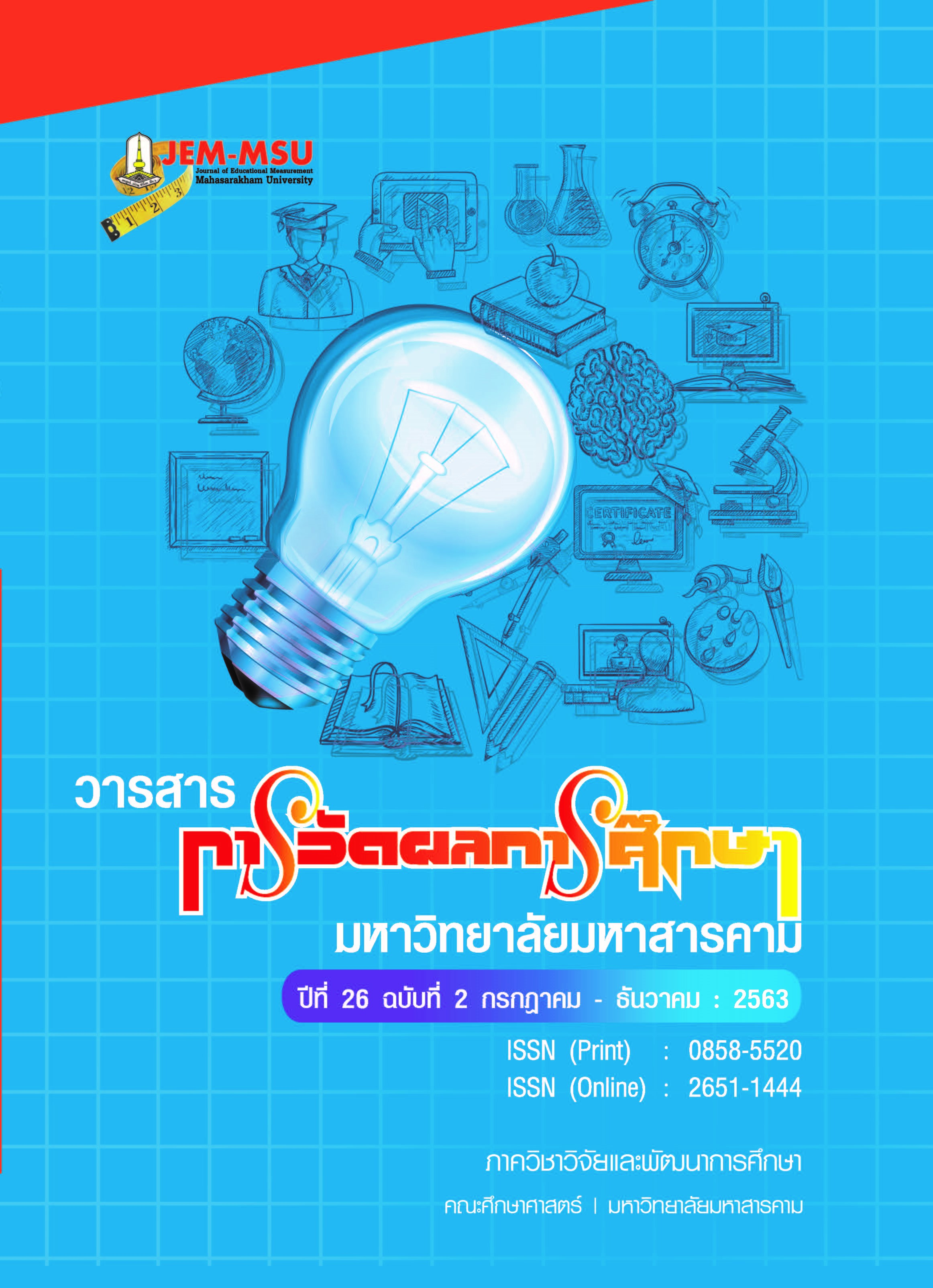Development of Mathematics Learning Activities on Decimal and Fraction for Grade 7 students Using CIPPA Learning Method to Promote Analytical Thinking and the Traditional Learning Activities
Main Article Content
Abstract
The purposes of this research were to: 1) develop mathematics learning activities using CIPPA learning method to promote analytical thinking on decimal and fraction for grade 7 students to meet a required efficiency of 75/75; 2) study the effectiveness index of organizing learning activities using CIPPA learning method to promote analytical thinking on decimal and fraction for grade 7 students; 3) compare mathematics learning achievements and mathematics analytical thinking ability on decimal and fraction for grade 7 students between CIPPA learning method to promote analytical thinking and the traditional learning activities; 4) study the students’ attitude on CIPPA learning method to promote analytical thinking on decimal and fraction for grade 7 students. The sample consisted of 60 grade 7 students from 2 classes in Roi Et Wittayalai School, Mueang District, Roi Et Province, in the second semester of the academic year 2017, obtained through cluster random sampling. The sample was divided into 2 groups: the experimental and the control groups. Each group made a mixed ability class, having high-achieving, moderate-achieving, and lower-achieving students. The experimental group used the learning activity organizing plan using CIPPA learning method to promote analytical thinking, and the control group used the traditional learning activity organizing plan. The research tools consisted of 18 learning activity organizing plans using CIPPA learning method and 18 learning activity organizing plans using the traditional method on decimal and fraction for grade 7 students; a 4-choice learning achievement test with 30 items; a 6-item subjective test for measuring analytical thinking ability; and a 15-item attitude test inquiring the students’ satisfaction with CIPPA learning method to promote analytical thinking. The statistics employed in data analysis were percentage, the mean, and standard deviation; Hotelling - T2 was employed in hypothesis testing.
The results of the study were as follows:
1. The learning activity organizing plan using CIPPA learning method to promote analytical thinking on decimal and fraction for grade 7 students that had been constructed by the researcher had the efficiency of 79.42 / 77.78.
2. The learning activity organizing plan using CIPPA learning method to promote analytical thinking on decimal and fraction for grade 7 students had the effectiveness index of 0.6875 or 68.52 percent.
3. The grade 7 students who studied with the learning activity organizing plan using CIPPA learning method to promote analytical thinking had their learning achievement and mathematics analytical thinking ability on decimal and fraction higher than those who studied with the traditional learning activities, with statistical significance at the .01 level.
4. The grade 7 students who studied with the learning activity organizing plan using CIPPA learning method to promote analytical thinking were satisfied with the organizing of learning activities, on the whole, at a highest level. In conclusion, organizing of learning activities using CIPPA learning method to promote analytical thinking on decimal and fraction for grade 7 students yielded an appropriate efficiency which increased the students’ learning achievement and analytical thinking ability; and the students were satisfied with organizing of learning activities using CIPPA learning method to promote analytical thinking at a highest level. Therefore, teachers should be supported to implement this method in organizing for learning and teaching in the future.
Article Details
The content and information contained in the published article in the Journal of Educational Measurement Mahasarakham University represent the opinions and responsibilities of the authors directly. The editorial board of the journal is not necessarily in agreement with or responsible for any of the content.
The articles, data, content, images, etc. that have been published in the Journal of Educational Measurement Mahasarakham University are copyrighted by the journal. If any individual or organization wishes to reproduce or perform any actions involving the entirety or any part of the content, they must obtain written permission from the Journal of Educational Measurement Mahasarakham University.
References
กรมวิชาการ. (2544). คู่มือการจัดการเรียนรู้ กลุ่มสาระการเรียนรู้คณิตศาสตร์. กรุงเทพฯ : องค์การรับส่งสินค้าและพัสดุภัณฑ์.
กระทรวงศึกษาธิการ. (2551). หลักสูตรแกนกลางการศึกษาขั้นพื้นฐานพุทธศักราช 2551. กรุงเทพฯ : โรงพิมพ์คุรุสภาลาดพร้าว.
กระทรวงศึกษาธิการ. (2553). หลักสูตรแกนกลางการศึกษาขั้นพื้นฐาน พุทธศักราช 2551. พิมพ์ครั้งที่ 3. กรุงเทพฯ : โรงพิมพ์ชุมนุม สหกรณ์การเกษตรแห่งประเทศไทย จำกัด.
จันที สิทธิศาสตร์. (2549). การพัฒนาแผนการจัดการเรียนรู้ โดยใช้ซิปปา (CIPPA MODEL) เรื่อง สมการเชิงเส้นตัวแปรเดียว ชั้นมัธยมศึกษาปีที่ 1. การศึกษาค้นคว้าอิสระปริญญาการศึกษามหาบัณฑิต มหาวิทยาลัยมหาสารคาม.
จิราภรณ์ ศิริทวี. (2541). เทคนิคการจัดกิจกรรมให้นักเรียนสร้างความรู้. วิชาการ. 1 (9), 37-52.
ทิศนา แขมมณี. (2553). ศาสตร์การสอน องค์ความรู้เพื่อการจัดการกระบวนการเรียนรู้ที่มีประสิทธิภาพ. พิมพ์ครั้งที่ 5). กรุงเทพฯ : สำนักพิมพ์แห่งจุฬาลงกรณ์มหาวิทยาลัย.
นิตยา ครอบบัวบาน. (2556). การเปรียบเทียบผลสัมฤทธิ์ทางการเรียน การคิดวิเคราะห์และความฉลาดทางอารมณ์ของนักเรียนชั้นมัธยมศึกษาปีที่ 3 ระหว่างการจัดการเรียนรู้ด้วยซิปปากับการจัดกิจกรรมการเรียนรู้ตามแนวทฤษฎีพหุปัญญา กลุ่มสาระการเรียนรู้คณิตศาสตร์. ปริญญานิพนธ์การศึกษามหาบัณฑิต สาขาวิชาหลักสูตรและการสอน คณะศึกษาศาสตร์ มหาวิทยาลัยมหามสารคาม.
เพ็ญฬภัทร์ ดีแก่นทราย. (2553). การเปรียบเทียบผลการเรียนรู้กลุ่มสาระการเรียนรู้คณิตศาสตร์ เรื่อง เศษส่วนและทศนิยม ของนักเรียนชั้นมัธยมศึกษาปีที่ 1 ระหว่างการจัดกิจกรรมการเรียนรู้โดยใช้สื่อโปรแกรม จีเอสพี กับการจัดกิจกรรมการเรียนรู้ตามปกติ. ปริญญานิพนธ์วิทยาศาสตรมหาบัณฑิต สาขาวิชาคณิตศาสตรศึกษา คณะวิทยาศาสตร์ มหาวิทยาลัยมหามสารคาม.
ไพรลิน พรมโสภา. (2556). การพัฒนาผลการเรียนรู้คณิตศาสตร์ เรื่อง สมการและการแก้สมการ ชั้นประถมศึกษาปีที่ 6 โดยการจัดการเรียนรู้แบบซิปปา. ปริญญานิพนธ์การศึกษามหาบัณฑิตสาขาวิชาหลักสูตรและการสอน คณะศึกษาศาสตร์ มหาวิทยาลัยมหามสารคาม.
ยุพิน พิพิธกุล. (2545). การสอนคณิตศาสตร์. กรุงเทพฯ : คณะครุศาสตร์ จุฬาลงกรณ์มหาวิทยาลัย.
วชิราภรณ์ จตุรพรสวัสดิ์. (2552). การเปรียบเทียบผลสัมฤทธิ์ทางการเรียน การคิดวิเคราะห์และความพึงพอใจต่อการเรียนคณิตศาสตร์ เรื่อง พื้นที่ผิวและปริมาตรของนักเรียน ชั้นมัธยมศึกษาปีที่ 3 ระหว่างการจัดการเรียนรู้แบบ CIPPA กับแบบ TGT. ปริญญานิพนธ์การศึกษามหาบัณฑิต สาขาวิชาหลักสูตรและการสอน คณะศึกษาศาสตร์ มหาวิทยาลัยมหาสารคาม.
วัลภา ปัชชาเขียว. (2555). การเปรียบเทียบผลสัมฤทธิ์ทางการเรียน ความสามารถในการให้เหตุผลและเจตคติต่อการเรียนวิชาคณิตศาสตร์ เรื่องทฤษฎีบทพีทาโกรัส ของนักเรียน ชั้นมัธยมศึกษาปีที่ 2 ระหว่างการจัดการเรียนรู้แบบ CIPPA กับการจัดการเรียนรู้โดยใช้สมองเป็นฐาน. ปริญญานิพนธ์การศึกษามหาบัณฑิต สาขาวิชาหลักสูตรและการสอน คณะศึกษาศาสตร์ มหาวิทยาลัยมหามสารคาม.
วัฒนาพร ระงับทุกข์. (2543). การสอนที่เน้นผู้เรียนเป็นศูนย์กลาง. (พิมพ์ครั้งที่ 3). กรุงเทพฯ : สำนักพิมพ์วัฒนาพานิช จำกัด.
วิมลรัตน์ สุนทรโรจน์. (2545). เอกสารประกอบการสอนวิชา 0506703 พัฒนาการเรียนการสอน. มหาสารคาม : มหาวิทยาลัยมหาสารคาม.
วิริยะ บุญยะนิวาสน์. (2537). มาพัฒนาการเรียนการสอนกันเถอะกลุ่มทักษะคณิตศาสตร์. วารสารประชากรศึกษา, 44(11), 26-32.
วีระยุทธ์ ศรีหาพล. (2558). การพัฒนากิจกรรมการเรียนรู้ กลุ่มสาระการเรียนรู้คณิตศาสตร์ เรื่อง อัตราส่วน ระดับประกาศนียบัตรวิชาชีพ ชั้นปีที่ 1 ระหว่างการจัดกิจกรรมการเรียนรู้แบบซิปปากับการจัดกิจกรรมการเรียนรู้แบบปกติ. ปริญญานิพนธ์วิทยาศาสตรมหาบัณฑิต สาขาวิชาคณิตศาสตรศึกษา คณะวิทยาศาสตร์ มหาวิทยาลัยมหามสารคาม.
สถาบันการทดสอบทางการศึกษาแห่งชาติ (องค์การมหาชน). (2559). ประกาศและรายงานผลโอเน็ต, 24 มีนาคม 2560. http://www.onetresult.niets.or.th/AnnouncementWeb/login.aspx


